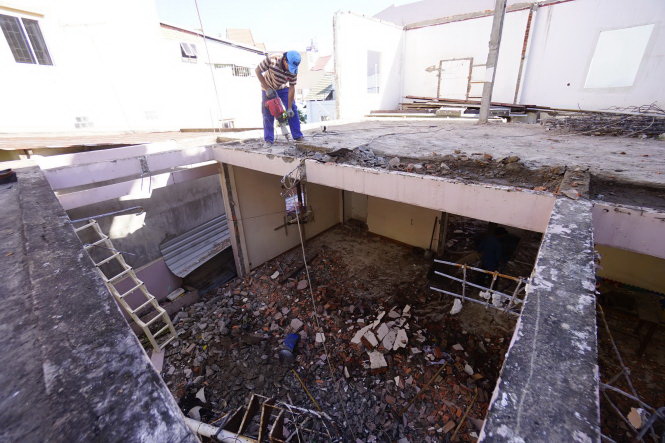Home demolition throughout Ho Chi Minh City can yield a good healthy profit as construction demand continues to rise.
Demolition workers can take on a wide array of structures ranging from average homes, villas to workshops, with their work characterized by technical challenges and risks.
Around 7:00 am on a typical morning, Trang Quang Cuong, 40, and his team begin pulling down a 6-meter-wide, two-story home in an alley on Ba Van Street, Tan Phu District.
According to Nguyen Son Hau, 31, drilling through the two tiled floors alone takes an entire day.
After bricks are all stripped off, he uses gas to remove iron bars from the walls.
Other workers then begin tearing down the walls, which takes great skill and flexibility when it comes to technically demanding nooks.
“Knocking down houses is even tougher than building new ones, as we are not aware of the buildings’ internal structure,” Cuong said.
Likewise, Le Cong Toan, 31, was keeping an eye on the breakdown of a house measuring merely three meters in width in Go Vap District.
He stressed that he and his team had taken great caution as the house is perilously close to several neighbors.
“We usually have to reinforce the walls of neighboring houses with iron splints before we start our work,” Toan said.
There are times when neighbors keep the workers from proceeding with the demolition until they make a commitment that their houses will be spared.
The workers find the removal of foundations the most challenging and time-consuming part, as the sturdy bases may take a few days to break up.
“The smaller the houses are, the more technically demanding and riskier the demolition becomes. But we’ve never said no to any pint-sized or unusually structured houses,” Cuong said.
Toan said he has pulled down different kinds of tiny houses over the past eight years.
These workers also clear away the wrecks of factories and construction sites.

Intact used bricks are sold to a dealer in Nha Be District, Ho Chi Minh City, before reaching cafés and eateries as decorative items. Photo: Tuoi Tre.
Such work is less technically demanding in comparison to what is involved in clearing homes since these sites are made up of steel structures which can be removed with relative ease one after another.
According to Pham Van Muoi, 46, he and other workers can put together a workshop at a new site following the demolition within a month.
He recalled a job that earned them a handsome sum several years ago when he and his group were paid approximately one million dong in total each time (VND1 million is equivalent to US$44.84).
Treasure out of trash
In recent years, wreck clearance has become more professional.
Wreck owners have come to realize the monetary value of items in the remains, including wooden doors, iron and steel rubble.
Demolition workers, who may turn scrap dealers, evaluate wrecks based on the number of doors and the volume of materials.
There are around 15 kilograms of iron, the most valuable item among the debris, in every square meter, with one kilogram fetching VND5,000 ($0.22), Toan said.
In rare cases, generous wreck owners allow the workers to keep all the items in the remains as long as the clearance is carried out quickly.
Demolition dealers typically purchase a two-floor house for VND15-20 million ($672-897), while villas, which boast costlier materials, usually sell for between VND50 million ($2,242) and hundreds of millions each.
If they do their calculation correctly, dealers can easily pocket a whopping VND100 million ($4,484) in profit by picking up a villa bargain, Toan added.
Dealers can also stumble upon antiques or age-old materials, including bricks dating back to French rule in Vietnam, which ended in 1954.
Such bricks, which can weigh up to seven kilograms apiece and fetch four to five times as much as normal ones, will be sold to intermediaries, who will in turn sell them to café or restaurant owners for decorative purposes.
One of Toan’s colleagues came across antique chairs, which were vended to local antique buffs for up to VND30 million ($1,345) apiece.
It takes years of experience to become successful demolition dealers, with most of them beginning the job as manual workers.
Some then open their own demolition and removal companies with their savings and can earn billions of dong (VND1 billion is equivalent to $44,840) in profit.
Cuong, for instance, left his hometown in the central province of Quang Ngai for Ho Chi Minh City around 20 years ago.
He worked as a dismantling laborer for eight years before saving enough to buy a used backhoe truck for more than VND100 million ($4,484).
Cuong now hires workers and owns three trucks worth over VND1 billion.
Like us on Facebook or follow us on Twitter to get the latest news about Vietnam!






















































